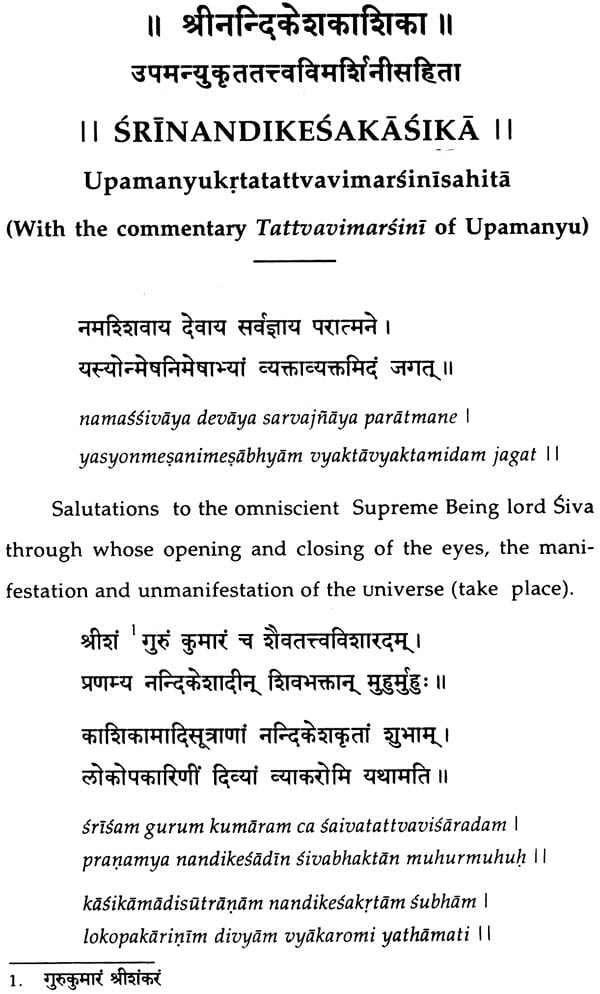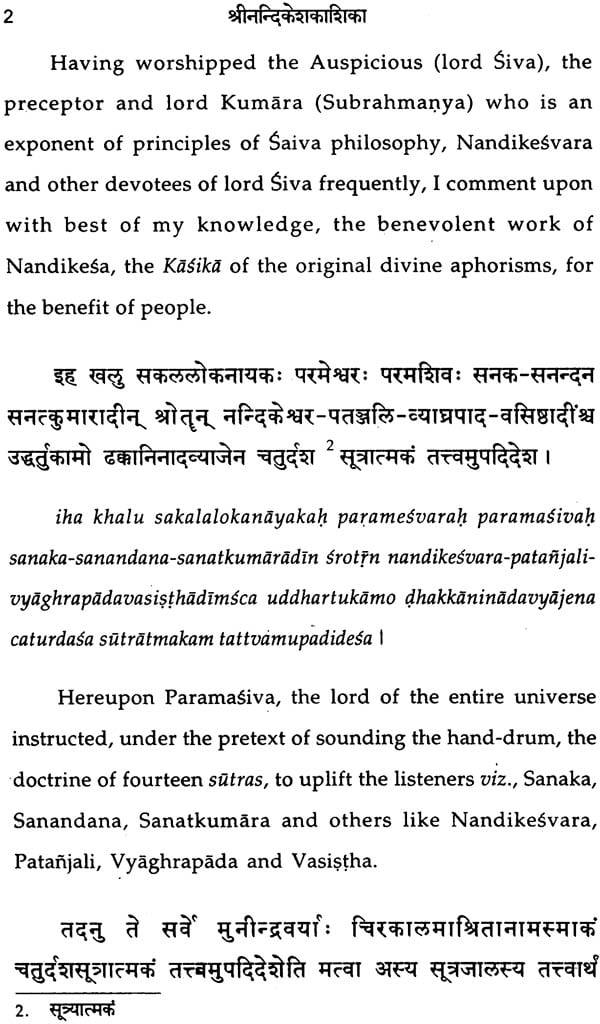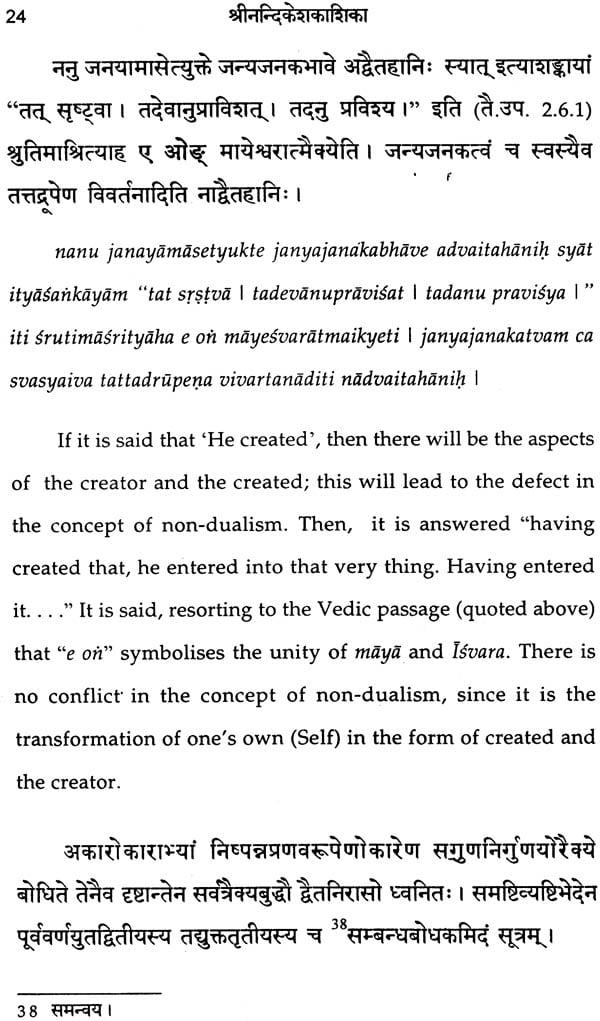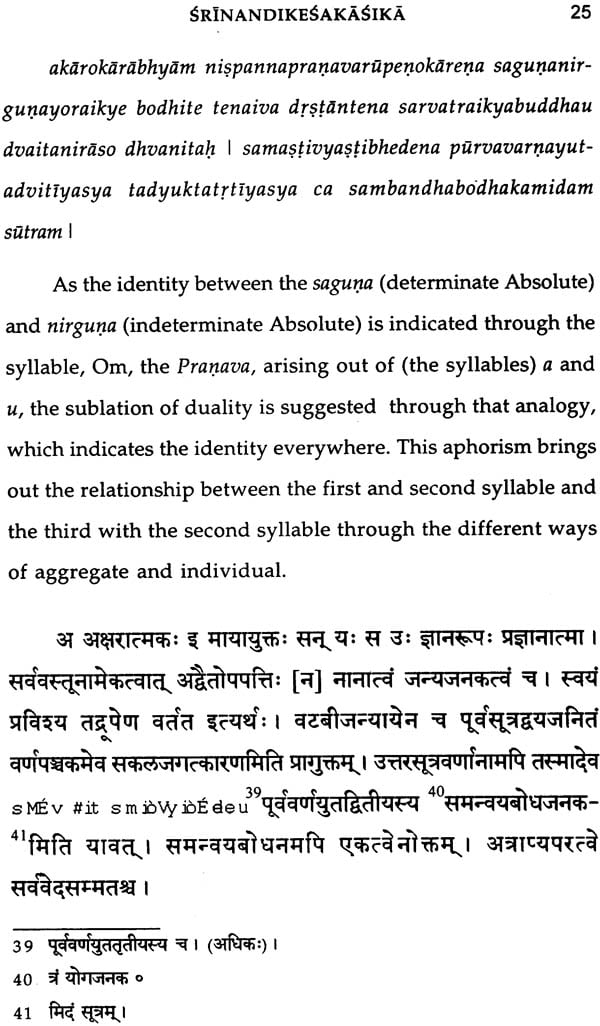
Sri Nandikesakasika (Sanskrit Commentry by Upamanyu)
Book Specification
| Item Code: | NAL425 |
| Author: | Dr. K.S. Balasubramanian |
| Publisher: | THE KUPPUSWAMI SASTRI RESEARCH INSTITUTE |
| Language: | Sanskrit Text with Transliteration and English Translation |
| Edition: | 2009 |
| ISBN: | 9788185170428 |
| Pages: | 60 |
| Cover: | Paperback |
| Other Details | 8.5 inch x 5.5 inch |
| Weight | 80 gm |
Book Description
Preface
It is with great pleasure that the Institute is bringing out the present edition of the text, Nandikesakasika ascribed to Nandi along with the commentary Tattvaprakasika of the legendary saint Upamanyu. The text provides mystical interpretation of the Mahesvarasutras of Panini’s Astadhyayi. While the text is quite brief and difficult to understand, the commentary is lucid and easy to comprehend.
The text and the commentary have been published long ago with Telugu and Tamil translations. These are not available now. Also they have been published by the Government Oriental Manuscript Library, Chennai (1950) and by the Vidya Vinodini press, Tanjore (1924).
The present edition by the Institute is mainly based on the GOML edition, in consultation with the Tanjore edition. This edition also carries both the Roman transliteration and English translation of the text and commentary, for the first time.
The publication is made possible by the munificent donation given by Mr. S. Hariharan, in memory of his wife Dr. S. Jayashree. We are deeply indebted to him for the same.
Dr. S. Jayashree, was a faculty member of our Institute, who was interested in different fields of Sanskrit Studies. She was the first to deviate from the beaten path and to enter into the field of Scientific in Sanskrit, in theInstitute. She wrote articles in the Journal of Oriental Research, Madras (published by the Institute), related to Earthquakes and Volcanoes and other natural phenomena.
She also carried out the project on Eclipses in Hindu Life and Thought at the Institute. It was later brought out as a book by the Institute. She was also engaged in the project on “Women in the Epics”.
The Institute dedicates this publication to Dr. S. Jayashree, who was a personal friend of the staff of the Institute.
This book is the result of the joint efforts of my colleagues Dr. K. S. Balasubramanian and Dr. T. v. Vasudeva, both Deputy Directors of the Institute. They have been ably assisted by the academic staff of the Institute-Mrs. R. Subasri, Mr. V. Ramakrishnan and Mr. S. N. Krishna in proof reading the text.
Our thanks are due to Mrs. M. Srividya of the Institute for type-setting the text and to Mr. B. Ganapathy Subramanian of the Madras Sanskrit College for the lay-out and wrapper designing.
Sri Harish Printers are to be thanked for the neat printing and nice get-up.
Introduction
Nandi or Nandikesvara is well Know as the chief of the Sivaganas. There are many stories about him narrated in Puranas. Besides, there is also a Purana in his name as Nandi or Nandikesvara purana, which according to R.C. Hazra belongs to 6-7 cent. A.D. and is lost now. According to legends, he was well versed in music. Many texts on different branches of knowledge like kamasastra, Ayurveda, yoga, Jyotisa and Vyakarana are ascribed to him. Of these, Abhinayadarpana, a text on music and dance, Netraprakasika on Ayurveda and Nandikesakasika on grammar have already been published.
The text, Nandikesakasika (-Karika) (NK) also known as Nandikesvarakasika or Kasikastava or Adisutrakasika consists of twenty seven verses containing mystical interpretation of the Sivasutras or the Pratyaharasutras of Panini’s Astadhyayi.
The fact that, Nagesa Bhatta quotes this verse in his well Known treatise Laghusabdendusekhara, brings to light the authenticity of the text.
Upamanyu, the legendary saint, has written the commentary Tattvavimarsini on NK, He is said to be the disciple of Dhaumya. According to another version, he is the son of Vyagrapada. The NCC (Vol. II. p. 368-69) lists some stotras authored by him. His Sivabhaktivilasa deals extensively on the lives of sixty three Tamil Saiva saints (Known as Nayanmars).
NK tries to highlight the salient features of Saiva philosophy, through the interpretation of the fourteen Mahesvara sutras. While the slokas or the karakas or the karakas by Nandikesvara are cryptic and difficult to understand, the commentary of Upamanyu is on the other hand lucid and explains the basic metaphysics of Saiva philosophy. It specially deals with the nature of Lord Siva, his supremacy as the creator, nature of maya, the four aspects of speech viz., para pasyanti, madhyama and vaikhari. This text also refers to the five karmendriyas, five jnanendriyas, five principal elements, (pancabhutas), five subtle elements (tanmatras), the Characteristics of the non-dual self and so on.
NK has been printed with Upamanyu’s commentary, Tattvavimarsini also called Tika or Vivarana, with Tamil and Telugu translations. But these publications were brought out more than seven decades ago and are not available for scholars now.
The present edition follows mainly the text with commentary edited by T. Chandrasekharan and published by the Government Oriental Manuscript Library, Chennai (Vol. III, Bulletin of the GOML, Madras, 1950) which is based on two manuscripts, one in Grantha script and the other a paper transcript of the manuscript of TMSSML, Tanjore. Another printed text of NK with commentary, published by Vidya Vinodini press (Tanjore, 1924), has also been consulted.
Some of the readings given in the footnotes of the GOML edition are found better than the ones in the main text. After consulting the other edition, we have tried to produce a readable text in Devanagari and Roman scripts for first time. Also the present edition carries an English translation of the kasika with the commentary, for the first time.
We are sure that scholars working in the field of Saivism and Vyakarana would welcome this publication.
Contents
| Preface | iii |
|
| Introduction | v |
|
| Text and Translation | 1 |
|









